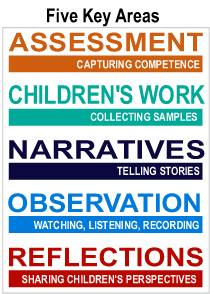 |
What is documentation? |
|
|
|
Documentation, in the education field, describes the process of gathering evidence of children’s learning through observation, work samples, conversation transcripts, and children’s and teachers’ reflections. This evidence is then analyzed, interpreted and shared. While high quality documentation may be displayed, a display does not necessarily constitute documentation. Rather, documentation is an ongoing process that entails discussion, teacher self-reflection and portfolio collections. Documentation can benefit all the important adults in children’s lives, and isinstrumental in cultivating a community of learners.
|
|

Resources
Beneke, S., Rearview mirror: A preschool car project: ERIC
Clearinghouse on Elementary & Early Childhood Education,
Champaign, Ill., 1998.
Bredekamp, S. & Rosegrant, T., Reaching potentials: Transforming
early childhood curriculum and assessment, Volume 2, National
Association for the Education of Young Children,
Washington, D.C., 1995.
Helm, J. H. & Beneke, S. (ed.), The Power of Projects: Meeting
Contemporary Challenges in Early Childhood Classrooms,
Teachers College Press, New York, 2002.
Helm, J. H. & Beneke, S., & Steinheimer, K., Teacher Materials for
Documenting Young Children's Work, Teachers College Press,
New York, 1998.
Helm, J. H. & Beneke, S., & Steinheimer, K., Windows on Learning:
Documenting Young Children's Work, Teachers College Press,
New York, 1998.
Helm, J.H. & Katz, L.G., Young Investigators: The Project Approach in
the Early Years, Teachers College Press, New York, 2001.
Katz, L. G. & Chard, S. C., The contribution of documentation to the
quality of early childhood education, ERIC Clearinghouse on
Elementary and Early Childhood Education, Champaign, Ill., 1996.
|
|
|
Why do we document children’s work?
- To share the value of active learning experiences.
- To determine the effectiveness of teaching strategies.
- To support the diverse ways children learn.
- To reliably assess children’s progress and meet accountability
requirements.
- To involve families in their children's education.
- To encourage teacher self-reflection and professional growth.
How do I start documenting?
- Gather tools, such as note paper, camera, folders and, perhaps, a
tape recorder.
- Select a learning experience to document.
- Think about how you will document. For example, document
learning in the block area with photographs, note-taking and
sketches of the structures children build.
- Review the documentation with colleagues. What do you see?
What did you learn?
- Make a small display or write a narrative as means of sharing
documentation.
- As a director or principal, provide the tools for documentation
and the time in faculty meetings to share it.
- Keep reading, learning, and sharing documentation.
|
Ideas for beginning documentation
For infants and toddlers: Capture developmental milestones using photographs and anecdotal notes. Display photos with captions that focus on accomplished milestones. (Example: Tyler learned to stand today by grasping the chair leg and pulling himself up with his arms.) Track language skills development by keeping vocabulary lists of understood and spoken words. Determine the value of learning experiences by documenting incidents of problem-solving.
For preschoolers: Document learning experiences and share them through class books or displays. Documenting achieved learning goals provides insights into the value of the preschool experience to parents, communities—and the teachers themselves. Collect writing and drawing samples several times during the year to accurately reflect children’s knowledge and skills development. As documenters gain proficiency, they can also capture problem-solving and routine events.
For kindergarteners and primary students: Include the accomplishment of specific standards or goals in your documentation. Portfolios are especially useful for measuring a child’s skills development when similar types of samples are collected throughout the year (such as a fall journal entry and a spring story). Create displays to demonstrate how children are meeting goals through integrated learning experiences. Children at this age level also can document and reflect on their own learning, individually and as part of a group.
|
| Assessment | Children's Work | Narrative | Observation | Reflections |
Made possible by a grant from

developed and designed by
Chicago Children’s Museum
Chicago Metro Association for the Education of Young Children
Judy Harris Helm, Best Practices, Inc.
For more information about The Power of Documentation and how you can bring it to your community,
please contact Tara Kennon at Chicago Metro AEYC by calling 312.427.5399 or emailing tkennon@chicagometroaeyc.org.
|
| |
|
 |
|


